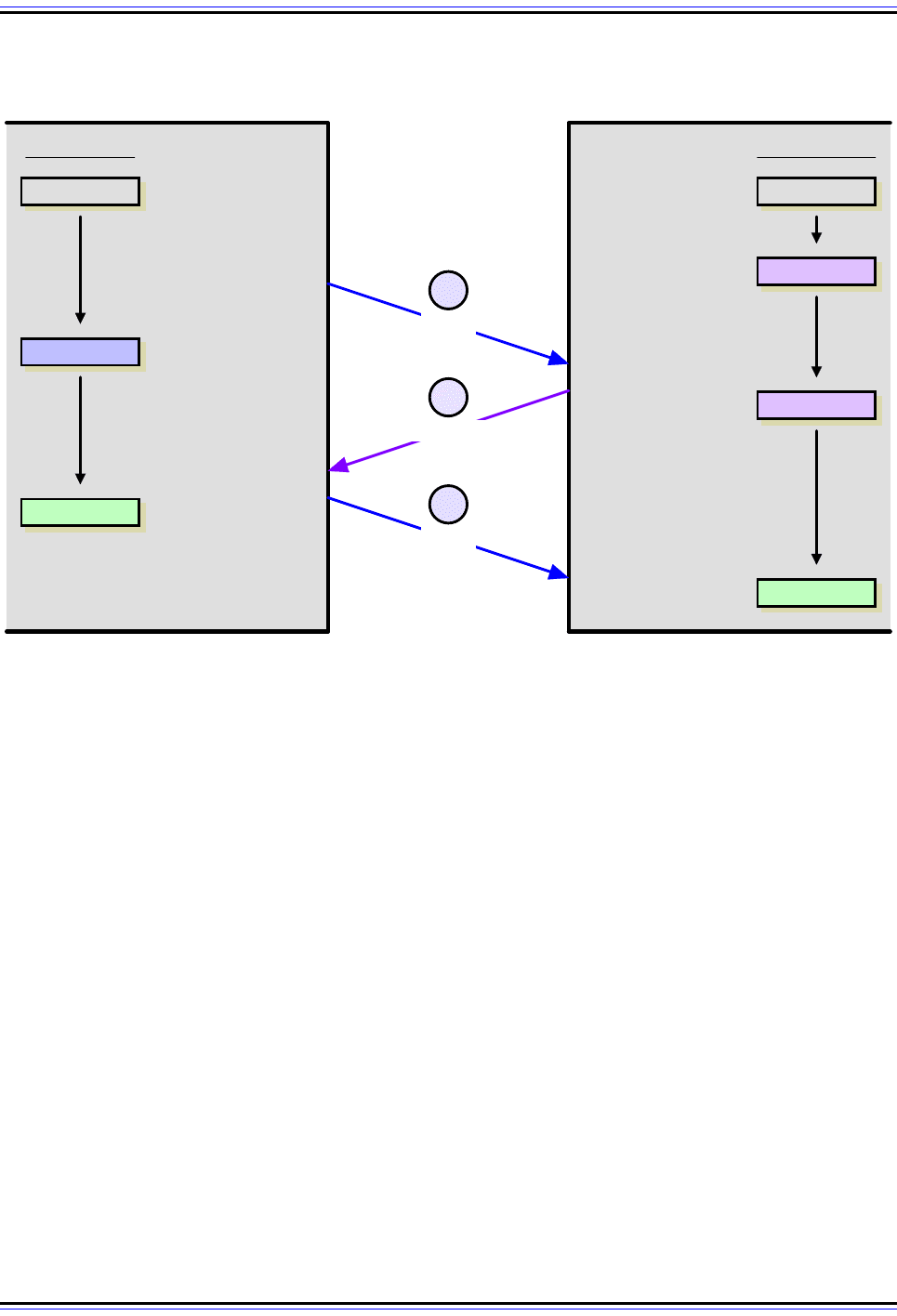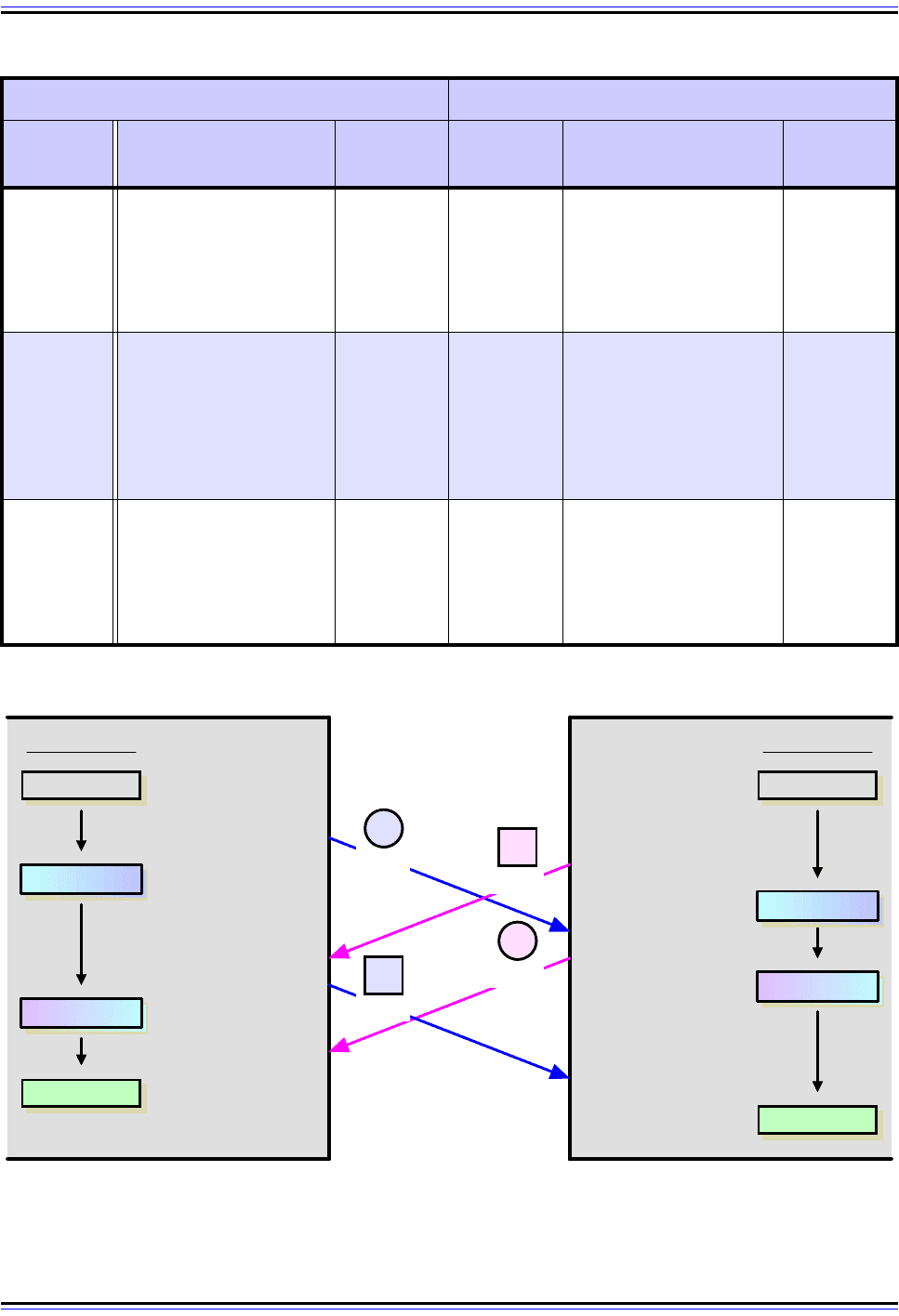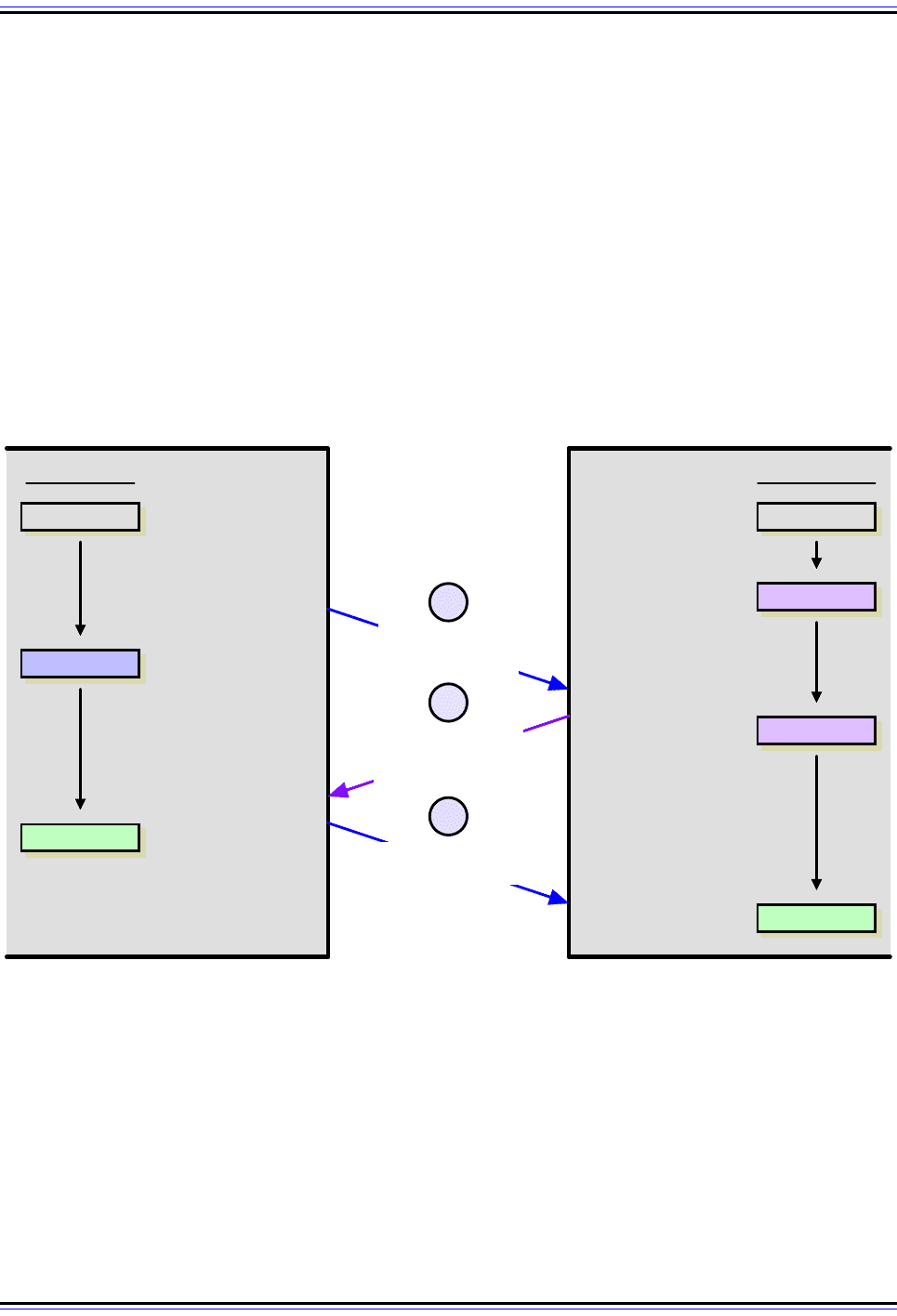Charles M. Kozierok The TCP-IP Guide
Подождите немного. Документ загружается.


The TCP/IP Guide - Version 3.0 (Contents) ` 871 _ © 2001-2005 Charles M. Kozierok. All Rights Reserved.
Preparation For Connection
Both the client and the server create the TCB for the connection at the time that they
perform the OPEN. The client already knows the IP addresses and port numbers for both
the client process and the server process it is trying to reach, so it can use these to uniquely
identify the connection and the TCB that goes with it.
For the server, the concept of a TCB at this stage of the game is a bit more complex. If the
server is in fact waiting for a particular client, it can identify the connection using its own
socket and the socket of the client for which it is waiting. Normally, however, the server
doesn't know what client is trying to reach it. In fact, it could be contacted by more than one
client nearly at the same time.
In this case, the server creates a TCB with an unspecified (zero) client socket number, and
waits for an active OPEN to be received. It then binds the socket number of the client to the
TCB for the passive OPEN as part of the connection process. To allow it to handle multiple
incoming connections, the server process may in fact perform several unspecified passive
OPENs simultaneously.
The transmission control block for a connection is maintained throughout the connection
and destroyed when the connection is completely terminated and the device returns to the
CLOSED state. TCP does include a procedure to handle the situation where both devices
perform an active OPEN simultaneously. This is discussed in more detail in the next topic
on the connection establishment process.
TCP Connection Establishment Process: The "Three-Way Handshake"
We have discussed in earlier topics in this section the connection orientation of TCP and its
operation. Before TCP can be employed for any actually useful purpose—that is, sending
data—a connection must be set up between the two devices that wish to communicate.
This process, usually called connection establishment, involves an exchange of messages
that transitions both devices from their initial connection state (CLOSED) to the normal
operating state (ESTABLISHED).
Connection Establishment Functions
The connection establishment process actually accomplishes several things as it creates a
connection suitable for data exchange:
☯ Contact and Communication: The client and server make contact with each other
and establish communication by sending each other messages. The server usually
doesn’t even know what client it will be talking to before this point, so it discovers this
during connection establishment.
☯ Sequence Number Synchronization: Each device lets the other know what initial
sequence number it wants to use for its first transmission.
☯ Parameter Exchange: Certain parameters that control the operation of the TCP
connection are exchanged by the two devices.

The TCP/IP Guide - Version 3.0 (Contents) ` 872 _ © 2001-2005 Charles M. Kozierok. All Rights Reserved.
Control Messages Used for Connection Establishment: SYN and ACK
TCP uses control messages to manage the process of contact and communication. There
aren't, however, any special TCP control message types; all TCP messages use the same
segment format. A set of control flags in the TCP header indicates whether a segment is
being used for control purposes or just to carry data. As I introduced in the discussion of the
TCP finite state machine, two control message types are used in connection setup, which
are specified by setting the following two flags:
☯ SYN: This bit indicates that the segment is being used to initialize a connection. SYN
stands for synchronize, in reference to the sequence number synchronization I
mentioned above.
☯ ACK: This bit indicates that the device sending the segment is conveying an acknowl-
edgment for a message it has received (such as a SYN).
There are also other control bits (FIN, RST, PSH and URG), which aren't important to
connection establishment, so we will set them aside for now. We'll discuss them in other
topics. In common TCP parlance, a message with a control bit set is often named for that
bit. For example, if the SYN control bit is set the segment is often called “a SYN message”.
Similarly, one with the ACK bit set is “an ACK message” or even just “an ACK”.
Normal Connection Establishment: The "Three Way Handshake"
To establish a connection, each device must send a SYN and receive an ACK for it from the
other device. Thus, conceptually, we need to have four control messages pass between the
devices. However, it's inefficient to send a SYN and an ACK in separate messages when
one could communicate both simultaneously. Thus, in the normal sequence of events in
connection establishment, one of the SYNs and one of the ACKs is sent together by setting
both of the relevant bits (a message sometimes called a SYN+ACK). This makes a total of
three messages, and for this reason the connection procedure is called a three-way
handshake.
Key Concept: The normal process of establishing a connection between a TCP
client and server involves three steps: the client sends a SYN message; the server
sends a message that combines an ACK for the client’s SYN and contains the
server’s SYN; and then the client sends an ACK for the server’s SYN. This is called the
TCP three-way handshake.
Table 153 describes in detail how the three-way handshake works (including a summary of
the preparation discussed in the previous topic). It is adapted from the table describing the
TCP finite state machine, but shows what happens for both the server and the client over
time. Each row shows the state the device begins in, what action it takes in that state and
the state to which it transitions. The transmit and receive parts of each of the three steps of
the handshake process are shown in the table, as well as in Figure 211.

The TCP/IP Guide - Version 3.0 (Contents) ` 873 _ © 2001-2005 Charles M. Kozierok. All Rights Reserved.
Table 153: TCP “Three-Way Handshake” Connection Establishment Procedure
Client Server
Start
State
Action
Move
To
State
Start
State
Action
Move To
State
CLOSED
The client cannot do
anything until the server
has performed a passive
OPEN and is ready to
accept a connection. (Well,
it can try, but nothing will be
accomplished until the
server is ready.)
— CLOSED
The server performs a
passive OPEN, creating a
transmission control block
(TCB) for the connection
and readying itself for the
receipt of a connection
request (SYN) from a
client.
LISTEN
CLOSED
Step #1 Transmit: The
client performs an active
OPEN, creating a trans-
mission control block (TCB)
for the connection and
sending a SYN message to
the server.
SYN-
SENT
LISTEN
The server waits for
contact from a client.
—
SYN-
SENT
The client waits to receive
an ACK to the SYN it has
sent, as well as the server's
SYN.
—LISTEN
Step #1 Receive, Step #2
Transmit: The server
receives the SYN from the
client. It sends a single
SYN+ACK message back
to the client that contains
an ACK for the client's
SYN, and the server's own
SYN.
SYN-
RECEIVED
SYN-
SENT
Step #2 Receive, Step #3
Transmit: The client
receives from the server
the SYN+ACK containing
the ACK to the client's
SYN, and the SYN from the
server. It sends the server
an ACK for the server's
SYN. The client is now
done with the connection
establishment.
ESTAB-
LISHED
SYN-
RECEIVED
The server waits for an
ACK to the SYN it sent
previously.
—
ESTAB-
LISHED
The client is waiting for the
server to finish connection
establishment so they can
operate normally.
SYN-
RECEIVED
Step #3 Receive: The
server receives the ACK to
its SYN and is now done
with connection
establishment.
ESTAB-
LISHED
ESTAB-
LISHED
The client is ready for
normal data transfer
operations.
ESTAB-
LISHED
The server is ready for
normal data transfer
operations.

The TCP/IP Guide - Version 3.0 (Contents) ` 874 _ © 2001-2005 Charles M. Kozierok. All Rights Reserved.
Simultaneous Open Connection Establishment
TCP is also set up to handle the situation where both devices perform an active OPEN
instead of one doing a passive OPEN. This may occur if two clients are trying to reach each
other instead of a client and a server. It is uncommon, however, and only happens under
certain circumstances.Simultaneous connection establishment can also only happen if a
well-known port is used as the source port for one of the devices.
In this case, the steps are different for both devices. Each client will perform an active
OPEN and then proceed through both the SYN-SENT and SYN-RECEIVED states until
their SYNs are acknowledged. This means there isn't a “three-way handshake” any more
as shown in Table 153. Instead, it is like two simultaneous “two-way handshakes”. Each
client sends a SYN, receives the other's SYN and ACKs it, and then waits for its own ACK.
The transaction, simplified, is described in Table 154 and Figure 212.
Figure 211: TCP “Three-Way Handshake” Connection Establishment Procedure
This diagram illustrates how a conventional connection is established between a client and server, showing
the three messages sent during the process and how each device transitions from the CLOSED state through
intermediate states until the session is ESTABLISHED.
Client Server
Wait For Server
SYN
SYN+ACK
Receive SYN,
Send SYN+ACK
Receive SYN+ACK,
Send ACK
CLOSED
Client State
Active Open: Create
TCB, Send SYN
SYN-SENT
CLOSED
Server State
Passive Open:
Create TCB
LISTEN
Wait For Client
#1
SYN- REC EIV ED
Wait for ACK
to SYN
EST ABLISHED
ACK
Wait for ACK
to SYN
Receive ACK
EST ABLISHED
#3
#2

The TCP/IP Guide - Version 3.0 (Contents) ` 875 _ © 2001-2005 Charles M. Kozierok. All Rights Reserved.
Table 154: TCP Simultaneous Open Connection Establishment Procedure
Client A Client B
Start
State
Action
Move To
State
Start
State
Action
Move To
State
CLOSED
Client A Step #1
Transmit: Client A
performs an active
OPEN, creating a TCB
and sending a SYN
message to the server.
SYN-SENT CLOSED
Client B Step #1
Transmit: Client B
performs an active
OPEN, creating a TCB
and sending a SYN to
the server.
SYN-SENT
SYN-SENT
Client B Step #1
Receive and Step #2
Transmit: Client A
receives Client B's SYN
and sends it an ACK. It
is still waiting for an ACK
to its own SYN.
SYN-
RECEIVED
SYN-SENT
Client A Step #1
Receive and Step #2
Transmit: Client B
receives Client A's SYN
and sends it an ACK. It is
still waiting for an ACK to
its own SYN.
SYN-
RECEIVED
SYN-
RECEIVED
Client A Step #2
Receive: Client A
receives the ACK from
Client B for its SYN and
is done with connection
establishment.
ESTAB-
LISHED
SYN-
RECEIVED
Client B Step #2
Receive: Client B
receives the ACK from
Client A for its SYN and
is done with connection
establishment.
ESTAB-
LISHED
Figure 212: TCP Simultaneous Open Connection Establishment Procedure
This diagram shows what happens when two devices try to open a connection to each other at the same time.
In this case instead of a three-way handshake, each sends a SYN and receives an ACK. They each follow the
same sequence of states, which differs from both sequences in the normal three-way handshake.
Client A Client B
Receive SYN,
Send ACK
Receive ACK
CLOSED
Client State
Active Open:
Create TCB,
Send SYN
SYN-SENT
CLOSED
Client State
Active Open:
Create TCB,
Send SYN
SYN- REC EIV ED
Receive SYN,
Send ACK
EST ABLISHED
Receive ACK
EST ABLISHED
SYN-SENT
SYN
SYN
#1
ACK
SYN- REC EIV ED
ACK
#2
#2
#1

The TCP/IP Guide - Version 3.0 (Contents) ` 876 _ © 2001-2005 Charles M. Kozierok. All Rights Reserved.
To keep the table size down, I have shown the activities performed by the two devices
occurring simultaneously (in the same row). In “real life” the actions don’t need to occur at
exactly the same time, and probably won’t. All that has to happen for the simultaneous
procedure to be followed is that each device receives a SYN before getting an ACK for their
own SYN, as Figure 212 shows.
Key Concept: If one device setting up a TCP connection sends a SYN and then
receives a SYN from the other one before its SYN is acknowledged, the two devices
perform a simultaneous open, which consists of the exchange of two independent
SYN and ACK message sets. The end result is the same as the conventional three-way
handshake, but the process of getting to the ESTABLISHED state is different.
TCP Connection Establishment Sequence Number Synchronization and
Parameter Exchange
The TCP three-way handshake describes the mechanism of message exchange that allows
a pair of TCP devices to move from a closed state to a ready-to-use, established
connection. Connection establishment is about more than just passing messages between
devices to establish communication. The TCP layers on the devices must also exchange
information about the sequence numbers each device wants to use for its first data trans-
mission, as well as parameters that will control how the connection operates. The former of
these two data exchange functions is usually called sequence number synchronization, and
is such an important part of connection establishment that the messages that each device
sends to start the connection are called SYN (synchronization) messages.
You may recall from the TCP fundamentals section that TCP refers to each byte of data
individually, and uses sequence numbers to keep track of which bytes have been sent and
received. Since each byte has a sequence number, we can acknowledge each byte, or
more efficiently, use a single number to acknowledge a range of bytes received.
The Problem With Starting Every Connection Using the Same Sequence Number
In the example I gave in the topic describing the sliding windows system, I assumed for
“simplicity” (ha ha, was that simple?) that each device would start a connection by giving
the first byte of data sent sequence number 1. A valid question is, why wouldn't we always
just start off each TCP connection by sending the first byte of data with a sequence number
of 1? The sequence numbers are arbitrary, after all, and this is the simplest method.
In an ideal world, this would probably work, but we don't live in an ideal world. ☺ The
problem with starting off each connection with a sequence number of 1 is that it introduces
the possibility of segments from different connections getting mixed up. Suppose we estab-
lished a TCP connection and sent a segment containing bytes 1 through 30. However, there
was a problem with the internetwork that caused this segment to be delayed, and
eventually, the TCP connection itself to be terminated. We then started up a new

The TCP/IP Guide - Version 3.0 (Contents) ` 877 _ © 2001-2005 Charles M. Kozierok. All Rights Reserved.
connection and again used a starting sequence number of 1. As soon as this new
connection was started, however, the old segment with bytes labeled 1 to 30 showed up.
The other device would erroneously think those bytes were part of the new connection.
This is but one of several similar problems that can occur. To avoid them, each TCP device,
at the time a connection is initiated, chooses a 32-bit initial sequence number (ISN) for the
connection. Each device has its own ISN, and they will normally not be the same.
Selecting the Initial Sequence Number
Traditionally, each device chose the ISN by making use of a timed counter, like a clock of
sorts, that was incremented every 4 microseconds. This counter was initialized when TCP
started up and then its value increased by 1 every 4 microseconds until it reached the
largest 32-bit value possible (4,294,967,295) at which point it “wrapped around” to 0 and
resumed incrementing. Any time a new connection is set up, the ISN was taken from the
current value of this timer. Since it takes over 4 hours to count from 0 to 4,294,967,295 at 4
microseconds per increment, this virtually assured that each connection will not conflict with
any previous ones.
One issue with this method is that it makes ISNs predictable. A malicious person could write
code to analyze ISNs and then predict the ISN of a subsequent TCP connection based on
the ISNs used in earlier ones. This represents a security risk, which has been exploited in
the past (such as in the case of the famous Mitnick attack). To defeat this, implementations
now use a random number in their ISN selection process.
TCP Sequence Number Synchronization
Once each device has chosen its ISN, it sends this value to the other device in the
Sequence Number field in its initial SYN message. The device receiving the SYN responds
with an ACK message acknowledging the SYN (which may also contain its own SYN, as in
step #2 of the three-way handshake). In the ACK message, the Acknowledgment Number
field is set to the value of the ISN received from the other device plus one. This represents
the next sequence number the device expects to receive from its peer; the ISN actually thus
represents the sequence number of the last byte received (fictitious in this case, since the
connection is new and nothing yet has been received). We'll see later on that this is
consistent with how these two fields are used for normal data exchange.
Key Concept: As part of the process of connection establishment, each of the two
devices in a TCP connection informs the other of the sequence number it plans to
use for its first data transmission by putting the preceding sequence number in the
Sequence Number field of its SYN message. The other device confirms this by incre-
menting that value and putting it into the Acknowledgment Number field of its ACK, telling
the other device that is the sequence number it is expecting for the first data transmission.
This process is called sequence number synchronization.

The TCP/IP Guide - Version 3.0 (Contents) ` 878 _ © 2001-2005 Charles M. Kozierok. All Rights Reserved.
Here's a simplified example of the three-way handshake steps showing how this is done
(see Figure 213 as well). I chose small ISNs for readability but remember that they can be
any 32-bit number:
1. Connection Request By Client: The client chooses an ISN for its transmissions of
4,567. It sends a SYN with the Sequence Number field set to 4,567.
2. Acknowledgment and Connection Request By Server: The server chooses an ISN
for its transmissions of 12,998. It receives the client's SYN. It sends a SYN+ACK with
an Acknowledgment Number field value of 4,568 (one more than the client's ISN). This
message has a Sequence Number field value of 12,998.
3. Acknowledgment By Client: The client sends an ACK with the Acknowledgment
Number field set to 12,999.
With the connection now established, the client will send data whose first byte will be given
sequence number 4,568. The server's first byte of data will be numbered 12,999.
Figure 213: TCP Sequence Number Synchronization
This diagram illustrates the same three-way handshake connection establishment procedure introduced in
Figure 211, except this time I have shown the Sequence Number and Acknowledgment Number fields in each
message so you can see how they are used by each of the two devices to establish initial sequence numbers
for data exchange.
Client Server
Wait For Server
SYN
Seq Num = 4,567
SYN+ACK
Ack Num = 4,568
Seq Num = 12,998
Receive SYN,
Send SYN+ACK
Receive SYN+ACK,
Send ACK
CLOSED
Client State
Active Open: Create
TCB, Send SYN
SYN-SENT
CLOSED
Server State
Passive Open:
Create TCB
LISTEN
Wait For Client
#1
SYN- REC EIV ED
Wait for ACK
to SYN
EST ABLISHED
ACK
Ack Num = 12,999
Wait for ACK
to SYN
Receive ACK
EST ABLISHED
#3
#2

The TCP/IP Guide - Version 3.0 (Contents) ` 879 _ © 2001-2005 Charles M. Kozierok. All Rights Reserved.
TCP Parameter Exchange
In addition to initial sequence numbers, SYN messages also are designed to convey
important parameters about how the connection should operate. TCP includes a flexible
scheme for carrying these parameters, in the form of a variable-length Options field in the
TCP segment format that can be expanded to carry multiple parameters. Only a single
parameter is defined in TCP 793 to be exchanged during connection setup: Maximum
Segment Size (MSS). The significance of this parameter is explained in the TCP data
transfer section.
Each device sends the other the MSS that it wants to use for the connection, if it wishes to
use a non-default value. When receiving the SYN, the server records the MSS value that
the client sent, and will never send a segment larger than that value to the client. The client
does the same for the server. The client and server MSS values are independent, so a
connection can be established where the client can receive larger segments than the server
or vice-versa.
Later RFCs have defined additional parameters that may be exchanged during connection
setup. Some of these include:
☯ Window Scale Factor: Allows a pair of devices to specify larger window sizes than
would normally be possible given the 16-bit size of the TCP Window field.
☯ Selective Acknowledgment Permitted: Allows a pair of devices to use the optional
selective acknowledgment feature to allow only certain lost segments to be
retransmitted.
☯ Alternate Checksum Method: Lets devices specify an alternative method of
performing checksums than the standard TCP mechanism.
TCP Connection Management and Problem Handling, the Connection Reset
Function, and TCP "Keepalives"
Once both of the devices in a TCP connection have completed connection setup and have
entered the ESTABLISHED state, the TCP software is in its normal operating mode. Bytes
of data will be packaged into segments for transmission using the mechanisms described in
the section on message formatting and data transfer. The sliding windows scheme will be
used to control segment size and to provide flow control, congestion handling and retrans-
missions as needed.
Once in this mode, both devices can remain there indefinitely. Some TCP connections can
be very long-lived indeed—in fact, some users maintain certain connections like Teln et
sessions for hours or even days at a time. There are two circumstances that can cause a
connection to move out of the ESTABLISHED state:
☯ Connection Termination: Either of the devices decides to terminate the connection.
This involves a specific procedure that is covered in the next topic in this section.
☯ Connection Disruption: A problem of some sort occurs that causes the connection to
be interrupted.

The TCP/IP Guide - Version 3.0 (Contents) ` 880 _ © 2001-2005 Charles M. Kozierok. All Rights Reserved.
The TCP Reset Function
To allow TCP to live up to its job of being a reliable and robust protocol, it includes intelli-
gence that allows it to detect and respond to various problems that can occur during an
established connection. One of the most common is the half-open connection. This
situation occurs when due to some sort of problem, one device closes or aborts the
connection without the other one knowing about it. This means one device is in the ESTAB-
LISHED state while the other may be in the CLOSED state (no connection) or some other
transient state. This could happen if, for example, one device had a software crash and was
restarted in the middle of a connection, or if some sort of glitch caused the states of the two
devices to become unsynchronized.
To handle half-open connections and other problem situations, TCP includes a special reset
function. A reset is a TCP segment that is sent with the RST flag set to one in its header.
Generally speaking, a reset is generated whenever something happens that is
“unexpected” by the TCP software. Some of the most common specific cases in which a
reset is generated include:
☯ Receipt of any TCP segment from any device with which the device receiving the
segment does not currently have a connection (other than a SYN requesting a new
connection.)
☯ Receipt of a message with an invalid or incorrect Sequence Number or Acknowl-
edgment Number field, indicating the message may belong to a prior connection or is
spurious in some other way.
☯ Receipt of a SYN message on a port where there is no process listening for
connections.
Handling Reset Segments
When a device receives a segment with the RST bit sent, it tells the device to reset the
connection so it can be re-established. Like all segments, the reset itself must be checked
to ensure that it is valid (by looking at the value of its Sequence Number field). This
prevents a spurious reset from shutting down a connection. Assuming the reset is valid, the
handling of the message depends on the state of the device that receives it:
☯ If the device is in the LISTEN state, the reset is ignored and it remains in that state.
☯ If the device is in the SYN-RECEIVED state but was previously in the LISTEN state
(which is the normal course of events for a server setting up a new connection), it
returns to the LISTEN state.
☯ In any other situation, the reset causes the connection to be aborted and the device
returns to the CLOSED state for that connection. The device will advise the higher-
layer process using TCP that the connection has been closed.
